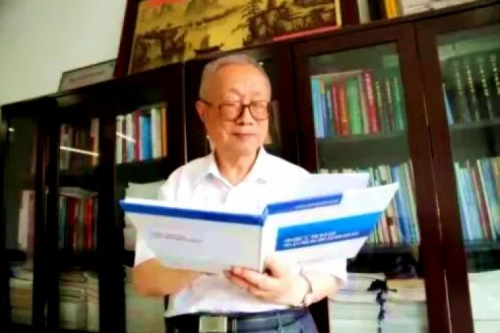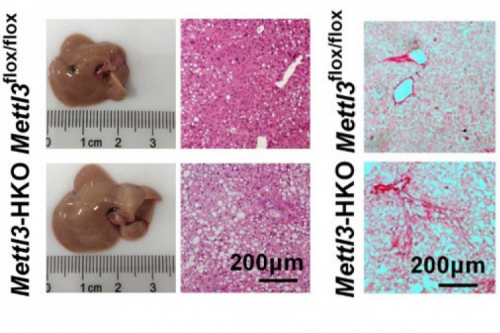HIT News---China’s Long March 5B carrier rocket made its debut flight at 18:00 on May 5 at the Wenchang Space Launch Center in Hainan province, which laid a solid foundation for the “third step” of China’s manned space program to construct a space station. From the first flight of Long March 5 to the first flight of Long March 5 B, myriad technologies from HIT have been applied, contributing HIT’s share for the successful launch of large carrier rockets.
The project of thermal protection of engine cylinders undertaken by Professor He Xiaodong's team from the Institute of Composite Materials and Structures of the School of Astronautics has successfully developed a lightweight, efficient, flexible and thermal insulation composite protection structure, which has obtained the qualification for space products and has the capability of mass production.Such protection structure was applied to the secondary engine of the Long March 5 carrier rocket and had conducted three missions.The research team adopted optimizing design method of continuous regulation and control in material microstructure, and developed a lightweight thermal insulation flexible thermal protection material with special fiber distribution, low density, excellent thermal insulation performance, three-dimensional curved surface bonding, flame retardant and non-moisture absorption characteristics, which gave full play to the performance characteristics of fiber materials.Both the engine cylinder assembly and the cylinder bracket employ the flexible thermal protection structure, and the surface temperature rise of the engine cylinder shell does not exceed 35℃ under the coupled working condition of radiation heat transfer and convective heat transfer formed by plume for up to 30 minutes, thus solving the thermal protection problem in the secondary engine compartment of Long March 5.
The nozzle extension of Long March 5 hydrogen and oxygen engine is formed by spirally winding, arranging and welding more than 300 thin-walled square tubes with variable cross sections, with a weld length of more than 1700 meters.The problems of poor stability of welding quality and low production efficiency existing in manual welding are difficult to ensure the fine and efficient welding requirements due to intensive launches of carrier rockets and high reliability.Professor Chen Yanbin's research team from the School of Materials has carried out technical research for nearly 10 years. Based on the theory of welding structural mechanics, a method of controlling deformation by dislocation welding of close-packed weld beads has been put forward to effectively solve the problem of welding deformation of ultra-thin special-shaped pipes.Three-stripe structured light recognition technology is adopted to break through the bottleneck of fillet weld recognition and tracking of large curvature trajectory. The automatic integration technology and equipment of nine-axis linkage robot have been developed, and the precise control of process parameters and process equipment has been realized.With HIT's style of "Strict criterions, solid skills ", his research team successively developed robot automatic welding equipment with international advanced level. It provided several sets of equipment to complete the technical upgrading and transformation of the production workshop, realized the automatic production of the tube bundle nozzle extension of the hydrogen and oxygen engine, and shortened the production cycle by more than half.
Metal rubber technology is tailored to solve the technical problems of damping and vibration reduction under extreme working conditions such as high vacuum, large temperature difference and strong radiation in the field of aerospace.The metal rubber damping ring has designable damping performance, and its combined structure can actualize vibration isolation of equipment under complex mechanical environment conditions.Professor Jiang Hongyuan and his team from the Institute of Metal Rubber Technology affiliated with theSchool of Mechanical and Electrical Engineering solved the problem of damping and vibration reduction for Long March 5 under extreme working conditions such as high vacuum, large temperature difference and strong radiation.Relying on the research and development foundation and advantages of HIT, the Institute of Metal Rubber Technology has focused on the country's major needs and aimed at technical bottlenecks to prepare metal rubber components that meet different working conditions and different structural requirements. Some metal rubber components have successfully replaced imported components on important equipment and have been successfully applied in Chang 'e-3 lander and other missions.
The research team headed by Professor Wang Liqinfrom the School of Mechanical and Electrical Engineering have undertaken the pre-research of ceramic bearings for low-temperature heavy-duty turbopumps of Long March 5 rocket core and upper-stage engines and the technical research of engineering prototypes.This is the first time in China that high-speed heavy-duty low-temperature self-lubricating ceramic bearings have been used on liquid hydrogen turbopumps.Thanks to the previous research accumulation in the application foundation of ceramic bearings, the team has conquered the core technologies and processes such as ultra-low temperature matching design technology of ceramic bearings, low damage and high precision manufacturing technology of ceramic balls, solid lubrication technology of self-lubricating cage materials and their transfer films, matching surface strengthening technology of bearing friction pairs, etc. Breaking through the core technology of high speed, heavy load, impact, ultra-low temperature and solid lubrication bearings, the team greatly improved the key indexes of rocket engine bearings. In the meanwhile, corresponding technical specifications have been established. All things above provide core technical support for the new generation of high-thrust hydrogen and oxygen rocket engines, making important contributions to the pre-research, scheme improvement, long-range test run and technical finalization of the Long March 5 rocket engine, thus paving the way for the development of higher-thrust rocket engines in China.
In addition to providing technical support, the design team spearheaded byyoung teacher Zhu Leialso designed logo for Long March 5.According to introduction, the concept and creativity of the logo scheme for Long March rocket familyoriginated from the Tai Chi pattern in traditional Chinese culture, showing a dynamic image of "5" as a whole---symbolizing thatLong March rockets seek comprehensive optimization including multiple factors such as performance, reliability, economy, safety and environmental protection.At the same time, its circular outline symbolizes the relationship between the brand and the sky, and symbolizes the complete success of Long March rocket family.In the overall color treatment of all-arrow painting, the red long five logo echoes the national flag, establishing a visual impression dominated by red on the basis of the large-area white tone of the whole arrow, strengthening the dominant position of Chinese elements from the perspective of visual communication. In brief, the overall painting form and color matching convey the visual semantics symbolizing the image of China as a big country.
Besides, the new-generation manned spaceship also carried the flag of the School of Astronautics of our school.From June 7 to 11, 2017, the School of Aeronautics held a series of thematic activities for the 30th anniversary of its establishment. At the "Aerospace and Me" thematic report meeting, members of the new spacecraft team of the manned space general department of the Fifth Institute of Aerospace Technology Group, representatives of alumni of the Academy of Aerospace and representatives of the Lilac micro-nano satellite team held a flying handover ceremony for the flag of the Academy of Aerospace. At the moment, the flag signed by the teachers and students of the School of Astronautics is accompanying the new-generation manned spacecraft flying in space.




